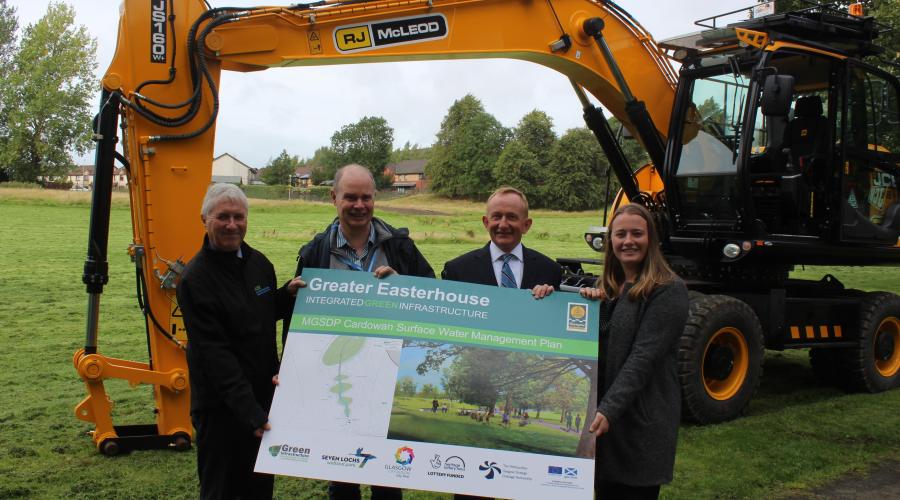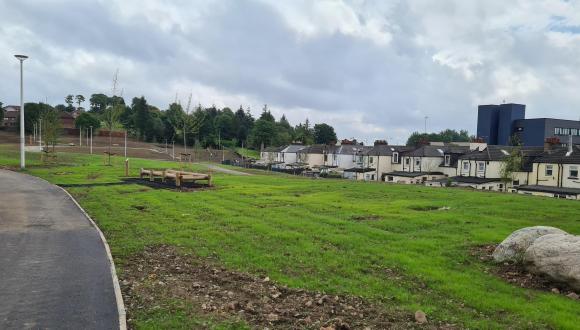
Outcomes and Horizontal Themes
The GISI's Vision was achieved by projects delivering against the Fund's five supporting Outcomes as as well as the ERDF 2014-2020 programme's three Horizontal Themes, which cut across all the activity it funds.
Our five Outcomes and three Horizontal Themes are listed below. Select a heading to find out more.
Outcome 1 – Nature, biodiversity and ecosystems
Improved green infrastructure enhances and restores the biodiversity and ecosystem function of an area, helping our urban ecosystems to be more resilient to change. By increasing the strength of the urban green network, it provides, restores and safeguards many more services to people and nature. Improvements to urban ecosystems provide benefits to people and take account of those people’s needs, improving livelihoods and quality of life, especially for those who are most disadvantaged. People value nature and the benefits it provides and are aware of the steps they can take to conserve it.
Greenspace and green infrastructure are linked through a habitat network which has better connections and reaches further into towns and cities, enabling movement of wildlife. Improved green infrastructure has a varied structure, with trees, shrubs and a variety of ground vegetation. Habitat networks are improved, increasing space for biodiversity and helping species to adapt to climate change. Better natural connections between urban and rural environments redress some of the losses resulting from our heavy industrial past.
Outcome 2 – Environmental quality, flooding and climate change
Our greenspaces and routes are multifunctional, providing improved ecosystem services for communities, helping us adapt to and mitigate climate change, improving our air and water quality, improving the ecological status of water bodies, managing surface water runoff and reducing flooding.
There are more buffer areas around greenspace, including traffic-calmed roads. Our streets are greener, with more street trees/vegetation. Routes between greenspaces contribute to a green network. Our rivers, streams and wetlands (blue network) are re-naturalised, with vegetated banks, gentler slopes and swales. This improvement allows us to create space for the restoration of urban rivers, and provides enhanced opportunities for community amenity, physical activity and well-being.
Opening up and re-naturalising our urban watercourses helps to reduce flooding and improve the quality of our urban rivers. Green infrastructure will change the way communities perceive storm water; it is no longer viewed as a problem but as a resource that contributes to making better places. The urban fabric is permeable, allowing rain to infiltrate into the ground, slowing the flow by collecting and moving surface water safely above ground into the natural river system and removing it from the sewerage system. In extreme rainfall events, green and blue infrastructure can be used to store water above ground and manage water safely through designated flood routes, reducing surface water runoff and managing surface water flooding. Run-off to rivers is reduced and water treated before it enters the river system, removing pollutants, improving water quality and managing river flooding.
Risks from climate change are reduced as communities and infrastructure are more resilient. Improved and new greenspace has reduced the impact of environmental problems like noise pollution, poor air and water quality, urban heating and flooding by improving the ecosystem services that urban land provides. Vegetation and soils absorb CO2 and other atmospheric pollutants. Water management through greenspace mitigates the threat of flooding to transport, power infrastructure and homes.
Outcome 3 – Involving communities and increasing participation
People feel confident and empowered to use their greenspace. There is a perception that crime, including ‘low level crime’ or anti-social behaviour is reduced. People use their greenspace more often and for a wider range of activities, both formal and informal. Schools and other organisations use greenspace for education, skills development, volunteering, recreation and play.
Enjoying the outdoors has become much more common and is part of our culture. People explore the area to experience nature, relax and stay fit. There is an increased choice of greenspace available with a range of different sizes, facilities, habitats, play equipment and experiences to visit close to home. Interpretation helps to make the sites and network easier to understand and use and explains what wildlife, facilities and activities can be found there, and what benefits they provide. There is a broad range of outdoor experiences that do not need prior knowledge. There are more community gardens, allotments and food production and more wild food can be collected.
More people use path networks and cycle routes because greenspaces are better linked together, including links to and between national way-marked routes.
Communities across Scotland understand and engage with their green places and efforts to improve them. Communities want to influence green infrastructure development and feel ownership and empowerment to use it to its full potential. Communities feel positive about green infrastructure investment and understand how it benefits them and want to engage with it and share their experience.
Communities close to or affected by green infrastructure are engaged and involved in the planning, management, improvement and use of their places and greenspaces. They see green infrastructure as a positive factor in the way their place functions and feel that the green elements of their environment add to their quality of life. Communities affected by green infrastructure improvements want to celebrate the improvements, and other communities are aware of and feel welcome to enjoy and experience these green places.
Outcome 4 – Increasing place attractiveness and competitiveness
Places are more attractive to live, work and invest in and more economically competitive as a result of green infrastructure improvements. More people use the greenspace and more people say that the greenspace meets their needs.
Greenspace provision is increased and enhanced, and deficits in access to greenspace for the most deprived communities are addressed. The quantity of vacant and derelict land is reduced and is transformed into positive and productive greenspace where communities need and want it.
Improvements in green infrastructure underpin and complement activities to increase economic activity in our most deprived communities. Businesses are attracted to locate in the area and local businesses emerge to make use of the greenspace resource. People feel confident and empowered within their communities to use their greenspaces for work, education and leisure. More people take regular exercise before, during and after work and school, and so are healthier and more productive.
Outcome 5 – Improving health and well-being
Greenspace becomes a central feature of people’s lives and they recognise and welcome the role it plays in their day to day well-being and happiness. Communities’ health and well-being improves through the use of greenspace.
Green infrastructure close to where people live provides health and recreational benefits and enhances their quality of life through improving the quality of their local environment and their sense of place. People of all ages and abilities feel safe and confident to use and enjoy their greenspace. More people benefit from recreation and formal and informal exercise in greenspace. People's mental health and well-being is better as a result of increased contact with nature and with their community.
Healthcare professionals increase their use of green prescribing as an alternative to prescription drugs or other therapies. Greenspace helps patients, visitors and staff to see their hospital or medical centre as a positive place.
Horizontal Theme - Sustainable Development
Sustainable development is described by the European Commission as “specific actions to take into account environmental protection requirements, resource efficiency, climate change mitigation and adaptation, disaster resilience and risk prevention and management”
This theme is particularly relevant to the ERDF Thematic Objective that the Green Infrastructure Strategic Intervention sits within – Objective 6: Preserving and protecting the environment and promoting resource efficiency.
In addition to projects which specifically focus on sustainable development, all projects should consider the impact their activities will have on sustainable development. In your application you will be asked to consider the impact your project may have on environmental protection requirements, resource efficiency, climate change mitigation and adaptation, disaster resilience and risk prevention and management, and identify potential mitigating and net-positive actions which will be undertaken during the delivery of the project.
Horizontal Theme - Equal Opportunities and Non-Discrimination
The European Commission describes Equal Opportunities and Non-Discrimination as taking…”appropriate steps to prevent any discrimination based on sex, racial or ethnic origin, religion or belief, disability, age or sexual orientation during the preparation and implementation of programmes. In particular, accessibility for persons with disabilities shall be taken into account throughout the preparation and implementation of programmes”.
All projects should demonstrate that they have considered the impact of the supported activities on groups with protected characteristics under the Equalities Acts and ensure that their application includes a description of specific actions they intend to take to actively prevent discrimination.
Applicants should design their project to take account of the needs of the groups at risk of discrimination, and in particular the requirements for ensuring accessibility for persons with disabilities.
Horizontal Theme - Equality Between Men and Women
The principle of Equality between Men and Women is outlined by the European Commission as ensuring that “…equality between men and women and the integration of gender perspective are taken into account and promoted throughout the preparation and implementation of programmes, including in relation to monitoring, reporting and evaluation.”





